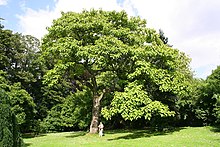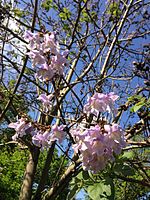Paulownia tomentosa
| Princess tree | |
|---|---|

| |
| Scientific classification | |
| Kingdom: | Plantae |
| Clade: | Tracheophytes |
| Clade: | Angiosperms |
| Clade: | Eudicots |
| Clade: | Asterids |
| Order: | Lamiales |
| Family: | Paulowniaceae |
| Genus: | Paulownia |
| Species: | P. tomentosa
|
| Binomial name | |
| Paulownia tomentosa (Thunb.) Steud.
| |
Paulownia tomentosa, common names princess tree,[1] empress tree, or foxglove-tree,[2] is a deciduous hardwood tree in the family Paulowniaceae, native to central and western China. It is an extremely fast-growing tree with seeds that disperse readily, and is a persistent exotic introduced species in North America,[3] where it has undergone naturalisation in large areas of the Eastern US.[4] P. tomentosa has also been introduced to Western and Central Europe, and is establishing itself as a naturalised species there as well.[5][6]
Etymology[]

The generic name Paulownia honors Anna Pavlovna of Russia.[7] The specific epithet tomentosa is a Latin word meaning ‘covered in hairs’.[8]
Description[]

This tree grows 10–25 m (33–82 ft) tall, with large heart-shaped to five-lobed leaves 15–40 cm (6–16 in) across, arranged in opposite pairs on the stem. On young growth, the leaves may be in whorls of three and be much bigger than the leaves on more mature growth.[9] The leaves can be mistaken for those of the catalpa.
The very fragrant flowers, large and violet-blue in colour[10] are produced before the leaves in early spring, on panicles 10–30 centimetres (4–12 in) long, with a tubular purple corolla 4–6 centimetres (1+1⁄2–2+1⁄4 in) long resembling a foxglove flower. The fruit is a dry egg-shaped capsule 3–4 centimetres (1+1⁄8–1+5⁄8 in) long, containing numerous tiny seeds. The seeds are winged and disperse by wind and water. Pollarded trees do not produce flowers, as these form only on mature wood.
Paulownia tomentosa requires full sun for proper growth.[11][12] It is tolerant of pollution and can tolerate many soil types. It can also grow from small cracks in pavements and walls. Paulownia can survive wildfires because the roots can regenerate new, very fast-growing stems.
Range[]
Native range[]
Asia[]
China[]
Korean peninsula[]
- Korean peninsula
Introduced range[]
Europe[]
In August 2021 the EPPO added P. tomentosa to its Alert List, not due to any particular known problem within Europe, but as a step to begin assessing whether it should be regarded as a problematic invader.[13]
- Austria, Belgium, Czech Republic, France (including Corsica), Germany, Hungary, Italy (including Sardinia and Sicily), Slovenia, Switzerland, United Kingdom
Africa[]
North America[]
United States[]
- Alabama, Arkansas, Connecticut, Delaware, Florida, Georgia, Hawaii, Louisiana, Maryland, Mississippi, New Jersey, New York, North Carolina, Ohio, Oklahoma, Oregon,[citation needed] Pennsylvania, South Carolina, Tennessee, Texas, Virginia, Washington, West Virginia
Oceania[]
Asian introduced range[]
Uses[]
Paulownia tomentosa is cultivated as an ornamental tree in parks and gardens. It has gained the Royal Horticultural Society's Award of Garden Merit.[14][15]
Because of its tolerance and flexibility, Paulownia functions ecologically as a pioneer plant. Its nitrogen-rich leaves provide good fodder and its roots prevent soil erosion. Eventually, Paulownia is succeeded by taller trees that shade it and in whose shade it cannot thrive.[11][12]
The characteristic large size of the young growth is exploited by gardeners: by pollarding the tree and ensuring there is vigorous new growth every year, massive leaves are produced (up to 60 centimetres (24 in) across). These are popular in the modern style of gardening which uses large-foliaged and "architectural" plants.
The soft, lightweight seeds were commonly used as a packing material by Chinese porcelain exporters in the 19th century, before the development of polystyrene packaging. Packing cases would often leak or burst open in transit and scatter the seeds along rail tracks. The magnitude of the numbers of seeds used for packaging, together with seeds deliberately planted for ornament, has allowed the species to be viewed as an invasive species in areas where the climate is suitable for its growth, notably Japan and the eastern United States.[16]
Composition[]
Some geranyl flavonoids can be found in P. tomentosa.[17]
Verbascoside can also be produced in hairy roots cultures of P. tomentosa.[18]
Pictures[]
Flowers

Trunk

Trunk bark

Fruit

Spent Fruit
Leaf

Young tree

Flowers
References[]
- ^ "Paulownia tomentosa". Natural Resources Conservation Service PLANTS Database. USDA. Retrieved 31 January 2016.
- ^ BSBI List 2007 (xls). Botanical Society of Britain and Ireland. Archived from the original (xls) on 2015-06-26. Retrieved 2014-10-17.
- ^ "Paulownia tomentosa". Texas Invasive Species Institute. Retrieved Aug 3, 2019.
- ^ "Paulownia tomentosa Seeds". www.seedaholic.com. Retrieved 2020-07-01.
- ^ "Paulownia tomentosa | Manual of the Alien Plants of Belgium". alienplantsbelgium.be. Retrieved 2020-03-20.
- ^ "Oxford University Plants 400: Paulownia tomentosa". herbaria.plants.ox.ac.uk. Retrieved 2020-07-01.
- ^ Coombes, Allen J. (2012). The A to Z of plant names. USA: Timber Press. pp. 312. ISBN 9781604691962.
- ^ Harrison, Lorraine (2012). RHS Latin for gardeners. United Kingdom: Mitchell Beazley. p. 224. ISBN 9781845337315.
- ^ "image comparing large and small trees". Archived from the original on 2012-02-04. Retrieved 2006-05-03.
- ^ Fitter, Alastair; More (2012). Trees. [CollinsGem]. ISBN 978-0-00-718306-7.
- ^ Jump up to: a b Clatterbuck, Wayne K.; Hodges, Donald G. (2004), Tree Crops for Marginal Farmland: Paulownia, With a Financial Analysis (PB1465) (PDF), The University of Tennessee, p. 8
- ^ Jump up to: a b Bonner, F. T. (December 1990). "Royal Paulownia". In Burns, Russell M.; Honkala, Barbara H. (eds.). Agriculture Handbook 654: Silvics of North America. Volume 2: Hardwoods. Washington, DC: Forest Service, United States Department of Agriculture.
|volume=has extra text (help) - ^ Jump up to: a b "Paulownia tomentosa". EPPO (European and Mediterranean Plant Protection Organization). Retrieved 2021-08-19.
- ^ "RHS Plant Selector - Paulownia tomentosa". Retrieved 16 January 2021.
- ^ "AGM Plants - Ornamental" (PDF). Royal Horticultural Society. July 2017. p. 72. Retrieved 21 April 2018.
- ^ Tom Remaley (2006-06-27). "Princess tree". Plant Conservation Alliance's Alien Plant Working Group Least Wanted.
- ^ C-geranyl compounds from Paulownia tomentosa fruits. Smejkal Karel, Grycova Lenka, Marek Radek, Lemiere Filip, Jankovska Dagmar, Forejtnikova Hana, Vanco Jan and Suchy Vaclav, Journal of natural products, 2007, vol. 70, no8, pp. 1244-1248
- ^ Establishment of transformed root cultures of Paulownia tomentosa for verbascoside production. H. Wysokiińska and M. Rózga, Journal of Plant Physiology, 1998, Volume 152, Issue 1, Pages 78–83, doi:10.1016/S0176-1617(98)80105-3
External links[]
| Wikimedia Commons has media related to Paulownia tomentosa. |
- Species Profile - Princess Tree (Paulownia tomentosa), National Invasive Species Information Center, United States National Agricultural Library. Lists general information and resources for Princess Tree.
- Paulowniaceae
- Trees of China
- Naturalized trees of Alabama








